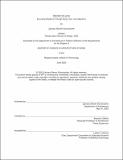| dc.contributor.advisor | Clifford, Brandon | |
| dc.contributor.author | Schumacher, Zachary Steven | |
| dc.date.accessioned | 2023-08-30T15:57:22Z | |
| dc.date.available | 2023-08-30T15:57:22Z | |
| dc.date.issued | 2023-06 | |
| dc.date.submitted | 2023-07-13T21:35:10.882Z | |
| dc.identifier.uri | https://hdl.handle.net/1721.1/151991 | |
| dc.description.abstract | The tools architects use orchestrate the discipline in seen and unseen ways. In recent decades, we have swapped early forms of mechanical drawing instruments for digital tools with unimaginable computing power. While this increased level of computational literacy allows us to script and code architectural forms more efficiently, it has also created incongruities between the computationally described object and material constructions. At times the digital tools we depend on today go as far as defining the aesthetic of our buildings. To complicate this further, the digital tools most often solicited by the architectural practice are non-native imports adapted for their visual potential and practical uses. Meaning embedded within the programming of tools that shape our buildings are residual values of other disciplines. For example, we can trace the origins of CAD software back to engineers and mathematicians at Boeing and here at MIT, who sought to mechanize the construction of splines and irregular curved surfaces for the production of slipstream automobiles, toothbrushes, and even letterforms. And much like the hidden algorithms in the background of our digital tools, there is an apparatus of choreography surrounding our physical tools that encode instructions on how the body engages with the object. In other words, the machines we use produce not only drawings but gestures as well, keying us into the always-present yet rarely discussed embodied dimensions of tools.
To expand upon the embodied dimensions of our tools today, we need to reconsider the machine as the site of intervention. Motion data and performance envelopes surrounding our tools extend beyond the projective reenactment of the machine and offer us a means to measure the derivative of what it takes to produce a drawing, a surface, or a construction. This thesis dislocates the spline from its formal geometry associated with slipstream construction and recasts it as a way to record the tumble-type inscriptions surrounding an object’s performance — a tactic to mutually mark and negotiate the activity between humans and machines. | |
| dc.publisher | Massachusetts Institute of Technology | |
| dc.rights | In Copyright - Educational Use Permitted | |
| dc.rights | Copyright retained by author(s) | |
| dc.rights.uri | https://rightsstatements.org/page/InC-EDU/1.0/ | |
| dc.title | Between the Lines: Encoding Relations Through Body, Tool, and Algorithm | |
| dc.type | Thesis | |
| dc.description.degree | S.M. | |
| dc.contributor.department | Massachusetts Institute of Technology. Department of Architecture | |
| dc.identifier.orcid | 0009-0004-7735-8964 | |
| mit.thesis.degree | Master | |
| thesis.degree.name | Master of Science in Architecture Studies | |
